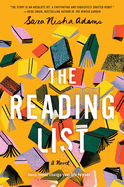
| Publisher: | Morrow | |
| Genre: | Friendship, World Literature, England - 21st Century, City Life, Asian American, Fiction | |
| ISBN: | 9780063025288 | |
| Pub Date: | August 2021 | |
| Price: | $27.99 |
| Fiction |
by Sara Nisha Adams
In Sara Nisha Adams's sweet, pleasing debut, The Reading List, two lonely characters in contemporary London--and a host of friends and family--learn just how much books, and other people, have to offer.
Mukesh is grieving after his wife's death: "Now here he was, alone, still without any clue as to what he should do now she was gone...." He wishes he were as close to his granddaughter, Priya, as she was to her grandmother, but he does not share their love of reading. Then he finds an unreturned library book his late wife loved and gives it a chance.
Aleisha, 17, works at the library, but begrudgingly. Her older brother is the reader in the family. Both are slowly being crushed by their mother's oppressive depression; they've lost touch with their friends and even each other, leaving Aleisha alone in the world, traveling between work and home until even the boring local library begins to feel like a sanctuary. In a returned book, she finds a handwritten note that begins, "Just in case you need it," with a list of book titles. Not knowing why, she tucks it away. Out of guilt and boredom, Aleisha begins reading the books on the found list and recommending them to the elderly Hindu man who has tentatively begun to visit her library.
The Reading List is a tender novel about human connection and community and the healing power of reading, about the support and compassion that all people need at one time or another. This book is a soothing salve. --Julia Kastner, librarian and blogger at pagesofjulia

| Publisher: | Dell | |
| Genre: | Women, Romance, Contemporary, Multicultural & Interracial, Fiction | |
| ISBN: | 9780593357170 | |
| Pub Date: | August 2021 | |
| Price: | $17 |
| Fiction |
by Sara Jafari
The Mismatch by Sara Jafari explores a British Iranian woman's sexual awakening and the double life she must lead when her family's religious and cultural rules clash with her desire to experience the freedom and choices enjoyed by her peers. Centered on the adventures of its young protagonist, Soraya Nazari, The Mismatch goes far beyond its romance genre to embrace themes of addiction, family trauma and redemption.
Readers are introduced to Soraya as she settles into post-graduate life in London, far from the prying eyes of her dysfunctional family in Brighton. Eager to find a job and gain sexual experience--not necessarily in that order--cerebral and quiet Soraya hatches a plan to ensnare former classmate and popular rugby star Magnus, so that she can experience her first kiss.
Propelled by a dual narrative format, the novel branches into one story line that follows Soraya and moves forward in time while another takes readers back to pre-revolutionary Iran and the coming-of-age drama of Soraya's mother, Neda, a student at the University of Tehran. Alternating chapters reveal how both mother and daughter find creative ways to circumvent strictly interpreted Islamic rules that forbid young men and women from socializing before marriage.
Jafari is the founder and editor of Token, a literary and arts magazine showcasing the work of underrepresented artists. Her thoughtful debut, skillfully merging a romantic premise with cultural drama, is sure to resonate with readers interested in stories that feature courageous women and the inventive strategies they deploy to navigate patriarchal religious conventions that exert control over female sexuality. --Shahina Piyarali, reviewer
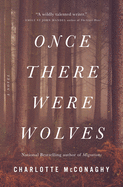
| Publisher: | Flatiron Books | |
| Genre: | Women, Literary, Fiction | |
| ISBN: | 9781250244147 | |
| Pub Date: | August 2021 | |
| Price: | $27.99 |
| Fiction |
by Charlotte McConaghy
Speaking to Shelf Awareness in 2020, Charlotte McConaghy said of her debut novel, Migrations, "It's about trying to defy the sense of personal hopelessness... and the pervasive fear that we are powerless" to stem the climate crisis. In McConaghy's beautiful and brutal follow-up, Once There Were Wolves, this tension between hope and despair again permeates a story of a woman fighting to repair ecological as well as personal devastation.
As girls, twins Inti and Aggie Flynn learned of nature's power to mend the human spirit. Their father preached that "the world turned wrong when we started separating ourselves from the wild," but that "we might survive this mistake if we found a way to rewild ourselves." Their mother taught another lesson: that the brokenness and cruelty inside people cannot be fixed, only guarded against. Now an adult, Inti travels to Scotland (with Aggie in tow), where she leads a team of biologists attempting to rehabilitate an area of Highland forest through the reintroduction of wolves. With the project facing fierce, even violent resistance from a suspicious public, Inti must protect not only her wolves--with whom she shares an increasing and perhaps dangerous level of identification--but her sister as well.
McConaghy excels at conveying the sensuous experience of nature and the emotions it provokes: wonder at its majesty, sorrow at its destruction. Unflinching in its view of the harm humans inflict on the environment and on each other--and insisting on the interconnectedness of the two--Once There Were Wolves delivers a powerful call for hope in the face of catastrophe. --Theo Henderson, bookseller at Ravenna Third Place Books in Seattle, Wash.
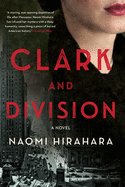
| Publisher: | Soho Crime | |
| Genre: | Mystery & Detective, Asian American, Fiction, Historical, Women Sleuths | |
| ISBN: | 9781641292498 | |
| Pub Date: | August 2021 | |
| Price: | $27.95 |
| Mystery & Thriller |
by Naomi Hirahara
The incarceration of 120,000 Americans of Japanese ancestry during World War II is undoubtedly one of the most egregious episodes in 20th-century U.S. history. Third-generation Japanese American Naomi Hirahara carves a little-known sliver from that grievous experience and layers it with mystery to create her provocative novel Clark and Division.
The War Relocation Authority eventually began releasing young adults to relocate in small numbers in such cities as Chicago, Denver and New York--because they were forbidden to return to their West Coast homes. In September 1943, Rose Ito was the first in her family to be discharged from Manzanar to resettle in Chicago. Her parents and younger sister, Aki, apply to follow her in the spring, but tragically, Rose is killed on the tracks of Chicago's Clark and Division subway station the night before the family's reunion. Her death is ruled a suicide, but "Rose wouldn't do that," Aki insists. She's convinced she knew her beloved, feisty, determined sister best, but is shocked when the coroner reports that Rose had had a recent abortion. Aki's doubts and questions immediately multiply. What she uncovers couldn't be more timely--anti-Asian racism and violence, illegal medicine, mob control, dirty cops.
Although she's skillfully integrated historical events in many of her previous titles, Hirahara's 10th novel incorporates three decades of researching and collecting the oral histories of Americans imprisoned for being of Japanese heritage. While Clark and Division is currently a standalone endeavor, Aki Ito shows plenty of intriguing tenacity to star in a series of her own. Readers are sure to agree. --Terry Hong, Smithsonian BookDragon
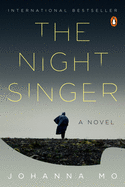
| Publisher: | Penguin Books | |
| Genre: | Crime, Thrillers, Fiction | |
| ISBN: | 9780143136682 | |
| Pub Date: | August 2021 | |
| Price: | $17 |
| Mystery & Thriller |
by Johanna Mo
To the list of tenacious Scandi detectives with baggage--among them Henning Mankell's Kurt Wallander and Jo Nesbø's Harry Hole--it's time to add a new name. As the nerve-rattling The Night Singer opens, Hanna Duncker has just moved from Stockholm back to Öland, from which she fled 16 years earlier, when her now-deceased father was imprisoned for a notorious murder.
On Hanna's first day at her new job with the Kalmar police, word arrives that the body of 15-year-old Joel Forslund has been found by a rest area. Hanna's father's legacy isn't the only facet of her past that she must confront--Joel is the son of her childhood best friend, with whom Hanna has been out of touch since she left Öland to escape the island's ill will toward her. The years haven't diminished at least one person's malice: Hanna begins receiving anonymous threatening phone calls that only heighten her resolve to find out "what really happened" 16 years earlier.
The first of Mo's books to be translated into English, The Night Singer offers an unexpected conclusion to its central mystery and leaves Hanna's personal quest tantalizingly unresolved, presumably to be teased in forthcoming titles in the projected Island Murders series. The novel is threaded with chapters from Joel's point of view that outline how he spent the last day of his life, which has the bittersweet effect of keeping him alive on the page and making his final moments, revealed at book's end, all the more crushing. --Nell Beram, author and freelance writer
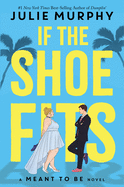
| Publisher: | Hyperion Avenue | |
| Genre: | Romantic Comedy, Fairy Tales, Folk Tales, Legends & Mythology, Romance, Contemporary, Fiction | |
| ISBN: | 9781368053372 | |
| Pub Date: | August 2021 | |
| Price: | $15.99 |
| Romance |
by Julie Murphy
With her upbeat and witty novel If the Shoe Fits, Julie Murphy starts off Disney's Meant to Be series, a collection of modern adult romantic comedies based on beloved Disney princesses.
If the Shoe Fits hits some of the beats readers expect from a Cinderella retelling, but subverts others. Rather than featuring a downtrodden and unwanted family member, Cindy's step-family is kind and Cindy herself is an aspiring shoe designer waiting for her chance to break out.
When her stepmother's reality dating show, Before Midnight, is short a few contestants, Cindy and her two step-sisters join the cast. But it turns out that Cindy has already met The Suitor on a flight, and he's a real-life Prince Charming. As Cindy progresses through the elimination rounds in the competition--not without more than her fair share of adversity--she becomes a reluctant media sensation and navigates fame, love and the impact of both on her career in footwear fashion.
Those familiar with Murphy's young adult work, including Dumplin' and Puddin', will cheer for the plus-size protagonist, who is self-confident but still fully realized, vulnerable and flawed. Murphy excels at writing fictional humans that feel like real people and Cindy, her family and her friends are no exception. Crisp banter, a sweet love story and a thoroughly heartwarming character arc make this Disney-for-adults novel a winner.
Readers looking for a closed-door rom-com with writing that sparkles and a refreshingly updated fairytale theme will be absolutely charmed. --Suzanne Krohn, editor, Love in Panels
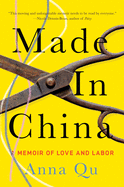
| Publisher: | Catapult | |
| Genre: | Biography & Autobiography, Family & Relationships, Abuse, Emigration & Immigration, Asian & Asian American, Cultural, Ethnic & Regional, Social Science, Child Abuse | |
| ISBN: | 9781646220342 | |
| Pub Date: | August 2021 | |
| Price: | $26 |
| Biography & Memoir |
by Anna Qu
For most of her first seven years, Anna Qu was "the girl without parents; a father dead, a mother who left to start a new life." And yet those years held the "love" Qu names in the subtitle of her bittersweet debut, Made in China: A Memoir of Love and Labor. Qu recalls being "wild, angry, and resentful" over her abandonment; more memorable, though, was being nurtured by devoted maternal grandparents in Wenzhou, China. At seven, Qu's mother--glamorously remade--transplanted Qu to Queens, N.Y., where "labor" would define the rest of her youth.
As a child immigrant living with her mother's new family, Qu became the perpetual stepchild. She was neglected, abused, beaten, banished. At nine, she attempted to throw herself out the window. By 13, she was the family's full-time housekeeper. At 14, she was sent to Xian to live with strangers, work in a factory, then sent to local school. Six months later, she returned to Queens to work in her parents' sweatshop. At 15, she finally confided in a school counselor, who alerted the Office of Child and Family Services; the outside work stopped, but her home life never improved. When she left for college, her mother made sure Qu knew she wasn't welcome back.
After getting her MFA, Qu requested her OCFS files. What the contents reveal is not what she remembers. In exposing that unreliability, Qu comes to the jarring realization of "how black and white I have made my entire life out to be." What will haunt readers are the indelible feelings--of loss, fear, anger and devastation, but, by book's end, somehow, she has love. --Terry Hong, Smithsonian BookDragon
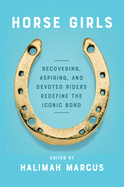
| Publisher: | Harper Perennial | |
| Genre: | Biography & Autobiography, Women, Feminism & Feminist Theory, Women Authors, Literary Collections, Social Science | |
| ISBN: | 9780063009257 | |
| Pub Date: | August 2021 | |
| Price: | $17 |
| Starred | Essays & Criticism |
by Halimah Marcus
"Riding promised a way to escape our circumstances and our bodies, our genders, our parents, our upbringings. On horseback, we weren't horses, but we weren't girls either," writes Halimah Marcus, executive director of Electric Literature, in the introduction to Horse Girls. This is a collection of 14 intimate and probing essays by writers exploring their past selves and their present selves in relation to the "horse girl" stereotype they might have once embodied, and the writers they became.
The anthology expands upon the exclusionary image of who can be a horse girl, looking beyond the icon of "heterosexuality, independence, whiteness, femininity," to the margins and borders of the equine world. Courtney Maum explores the physicality of polo in "Playing Safe." Nur Nasreen Ibrahim considers the coloniality of horseback riding in the hill stations of Pakistan in "The Shrinking Mountain." And Sarah Enelow-Snyder writes about searching for perfection on horseback as a young Black girl who did not have the opportunities to see others like her in the showring or embracing a life on horseback in "A Racer without a Pedigree."
If riding horses means borrowing freedom, as the adage goes, this anthology most powerfully and poignantly grapples with what someone might be trying to free themselves from when they seek out these animals. These writers' stories will resonate with those who were themselves, or have ever loved, a horse girl. Each piece reflects the pain, love, gentleness and complexities of life that are wrapped up in that bond. --Michelle Anya Anjirbag, freelance reviewer
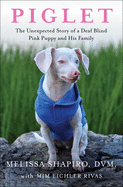
| Publisher: | Atria Books | |
| Genre: | Biography & Autobiography, Pets, Dogs, Personal Memoirs, General, Essays & Narratives | |
| ISBN: | 9781982167165 | |
| Pub Date: | August 2021 | |
| Price: | $26 |
| Pets |
by Melissa Shapiro, Mim Eichler Rivas
Sometimes, the little things in life have the power to change everything. Such was the case with Connecticut veterinarian Melissa Shapiro, who was asked by a local animal rescue organization to foster a barely two-pound puppy that was deaf, blind and morbidly skittish.
Piglet--named because of his pink coloring--was added to the family pack that included Shapiro's husband, three college-aged kids and six other dogs. Through weeks of trying to calm and stabilize the traumatized little puppy, Shapiro provided canine comfort through lots of love, the familiarity of established routines and developing a touch-style of sign language. When it came time to release the dog from foster care, Shapiro was faced with a dilemma: Did she really want someone else taking care of a dog she and her family had fallen in love with?
Thus, Shapiro embarked on a new chapter where she adopted Piglet and decided to share him--and the lessons of his life--with the world. His popularity soared on social media, where he raised awareness about special needs rescue organizations and other animal causes. This later led to Shapiro establishing an educational outreach program where Piglet--severely disabled, yet a joy-filled, loving teacher--helped children learn how to accept and work through life challenges.
Shapiro's inspirational memoir--candid details of her veterinary career, her family, lovable Piglet and his incredibly sweet, resilient spirit--will win hearts. --Kathleen Gerard, blogger at Reading Between the Lines
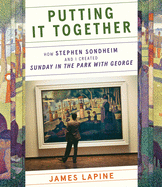
| Publisher: | Farrar, Straus and Giroux | |
| Genre: | Theater, History & Criticism, Broadway & Musicals, Performing Arts | |
| ISBN: | 9780374200091 | |
| Pub Date: | August 2021 | |
| Price: | $40 |
| Starred | Performing Arts |
by James Lapine
Theater buffs, acting students and budding playwrights will love this delicious masterclass on creating a Broadway musical. In 1982, Lapine began collaborating with Stephen Sondheim to create Sunday in the Park with George. Sondheim wrote the songs while Lapine wrote the book and directed the 1984 Broadway production. "Memory is uniquely personal and, as time passes, the facts of an event are often rewritten to reflect the teller and the stories he or she chooses to hold true," writes Lapine, explaining his decision to interview 40 people connected with the production. These conversations are presented throughout the book in a q&a format and form an oral history.
The conversations between Lapine and Sondheim are fascinating and insightful, especially detailing their writing routines. Sondheim still follows his training under Oscar Hammerstein: "Always think character and story, and then you think about the song." Sondheim's anecdotes also create delightful and precise mini-portraits of previous collaborators (Arthur Laurents, Hal Prince, Hugh Wheeler and others). Lapine's conversations with cast members (including Bernadette Peters, Mandy Patinkin and Christine Baranski) are also expansive, covering the production of George and other shows. Kudos to Lapine for keeping in some thorny conversations that don't always show him in the best light--he reminds Brent Spiner of their clashes on two projects, and Spiner replies, "Yes. You were new to the game. You didn't have a vocabulary to talk to actors."
Putting It Together offers musical theater fans front row center seats to creating a Broadway show with an impeccable lineup of tour guides. --Kevin Howell, independent reviewer and marketing consultant
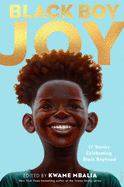
| Publisher: | Delacorte Press | |
| Genre: | United States - African American & Black, People & Places, Short Stories, Boys & Men, Juvenile Fiction | |
| ISBN: | 9780593379936 | |
| Pub Date: | August 2021 | |
| Price: | $16.99 |
| Starred | Children's & Young Adult |
by Kwame Mbalia, editor
Black boys in the United States have been taught to suppress their emotions, to show strength and, most importantly, never show fear. In this affecting collection, author/editor Kwame Mbalia (Tristan Strong Punches a Hole in the Sky) brings together the stories of 16 Black male and non-binary authors. Black Boy Joy allows Black boys to see other young Black individuals be fully themselves: vulnerable, happy and free.
"Black Boy Joy" is a term coined by Danielle Young in 2016 that "has grown to encompass the revelry, the excitement, the sheer fun of growing up as boys in and out of the hood." This anthology includes 17 adventurous short stories from Black children's and teen authors such as B.B. Alston, Jay Coles, Julian Randall and Jason Reynolds. In these stories, Black boys are able to cry, laugh, be indifferent, have uncommon interests and even compete in intergalactic races. Black Boy Joy mixes stories of loss, grief and finding one's voice with others that focus on the everyday, like picking out the perfect outfit for the first day of school, playing sports or performing in front of a large crowd.
Although Black Boy Joy is written for a very specific audience, Mbalia and the other authors tell the stories of young Black men with such vivid, expansive descriptions that all readers can experience the joy that radiates through the pages of this book. Anyone, no matter their age or ethnicity, can feel and have a sense of pride in themselves after reading this excellent anthology. --Natasha Harris, freelance reviewer
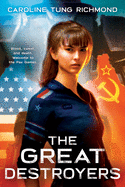
| Publisher: | Scholastic Press | |
| Genre: | People & Places, United States - Asian American, United States - 20th Century, Young Adult Fiction, Alternative History, Historical | |
| ISBN: | 9781338266740 | |
| Pub Date: | August 2021 | |
| Price: | $18.99 |
| Children's & Young Adult |
by Caroline Tung Richmond
In this exciting alternate-history YA novel written by Caroline Tung Richmond (The Only Thing to Fear), Cold War rivalries play out through a massive mecha fighting tournament.
Josephine Linden grew up in an alternate United States where the atomic bomb was never invented and wars are fought by soldiers in giant mechanical suits. The U.S. and the Soviet Union are locked in a Cold War and tensions run all the higher as the two nations clash in the 1963 Pax Games, an international mecha fighting tournament that is described as "the Olympics but bigger, bloodier, and deadlier." Jo, "the only female fighter in [her] school district," is relatively unknown despite her impressive record, so it comes as a surprise when she is invited to join Team USA. Victory in the Pax Games could be a ticket out of poverty for Jo's family, but things turn deadly serious when competitors mysteriously begin to fall ill. Jo, not quite prepared for the level of deceit and danger surrounding the Games, soon gets caught up in a political conspiracy.
The Great Destroyers balances suspenseful action sequences with explorations of identity and prejudice. Jo, used to being discounted as one of the few girls in a male-dominated sport, must also conceal her half-Chinese heritage to compete. Jo worries she won't be allowed to represent her country if people "knew what my mother looked like." A tournament setting may be familiar for many readers of YA fiction, but Jo's distinct voice and search for acceptance make this novel stand out. --Alanna Felton, freelance reviewer
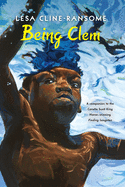
| Publisher: | Holiday House | |
| Genre: | United States - African American & Black, People & Places, Death, Grief, Bereavement, Parents, Family, United States - 20th Century, Social Themes, Juvenile Fiction, Historical | |
| ISBN: | 9780823446049 | |
| Pub Date: | August 2021 | |
| Price: | $17.99 |
| Children's & Young Adult |
by Lesa Cline-Ransome
In this stirring final novel in Lesa Cline-Ransome's Finding Langston trilogy, one boy's experience after losing his father is woven into the vastness of the Black experience in 1940s Chicago during the Great Migration.
Clem's father, a navy soldier, died in San Francisco's infamous 1944 Port Chicago munitions explosion, along with hundreds of other Black sailors. The effects of the disaster ripple out to nine-year-old Clem and his family: his depressed mom must go to work as a maid for a wealthy white family and Clem himself is unsure he'll ever measure up to his "big, strong, and in charge" father. This smart kid is scared to swim, to choose his own friends, to stand up for himself and others. Clem wonders if his only strength is his brains. At school, he befriends two boys with whom he has little in common. Although the bullying ways of Lymon (featured in Leaving Lymon) and Errol make him uncomfortable, the protection they offer from other bullies is, at first, a compelling reason to stick by them. But when their persecution of the new boy, Langston (introduced in Finding Langston), goes too far, Clem begins to act on his own, finally to know what it means to "be" Clem. "There ain't nothing brave about beating on someone who doesn't want to fight back."
Coretta Scott King Author honoree and Scott O'Dell Award medalist Cline-Ransome incorporates events of mid-century American history so seamlessly, young readers may not realize they're absorbing real historical facts. Being Clem, which includes an informative author's note at book's end, works beautifully as a stand-alone or as a companion to the earlier novels in the trilogy. --Emilie Coulter, freelance writer and editor